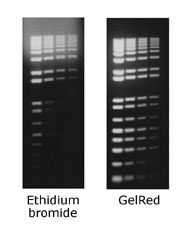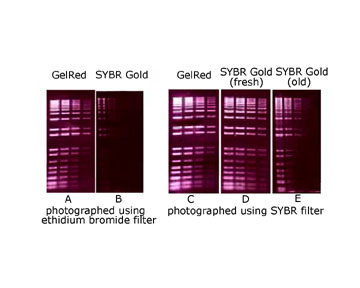A toxic death for ethidium bromide
8 Oct 2006 by Evoluted New Media
Ethidium bromide is one of the most widely used nucleic acid stains in molecular biology laboratories and being both highly toxic and a mutagen, the one most likely to cause your health and safety officer headaches! Here Helen Baker examines some alternatives
Ethidium bromide is one of the most widely used nucleic acid stains in molecular biology laboratories and being both highly toxic and a mutagen, the one most likely to cause your health and safety officer headaches! Here Helen Baker examines some alternatives
Ethidium bromide is an intercalating agent commonly used in the laboratory to detect nucleic acids, in particular double stranded DNA. In agarose gel electrophoresis it labels DNA from PCR experiments or restriction digests with the aim of: sizing nucleic acid fragments; quantifying DNA; extracting DNA of a particular size for cloning purposes; or isolating full length PCR products from partial products and surplus nucleotides.
Although a highly sensitive stain, ethidium bromide is notoriously unsafe. Not only is it a very strong mutagen, it may also be a carcinogen or teratogenic. Its MSDS documents state that it is harmful if swallowed and very toxic by inhalation, as well as being irritating to the eyes, respiratory system and skin. Additionally it carries the risk of irreversible effects. Ethidium bromide can therefore pose a major safety problem for the researcher and be an environmental hazard during disposal.
A number of safer nucleic acid labels suitable for use in electrophoresis are available on the market. GelRed and GelGreen, for example, have improved safety over ethidium bromide. Initial mutagenicity tests on the dyes – conducted by both the manufacturer, Biotium, and externally by Litron Laboratories, a material toxicity test company – indicate that GelRed and GelGreen both have either undetectable or very weak mutagenic effect in the absence or presence of rat liver extracts S9.
These dyes were designed with safety in mind. It was reasoned that for a DNA dye to be mutagenic, it must be able to cross the cell membrane. Thus, as a first line of defence, an innovative structure was used for the gel stain molecule making it extremely difficult to cross cell membranes.
In addition, it was recognised that once a DNA dye enters a cell it might be subject to metabolism which could convert the dye into a chemical that could be either more mutagenic (as in the case of ethidium bromide) or less mutagenic than the unmetabolised original. Thus, as a second line of defence, chemical bonds were incorporated at strategic positions in the dye molecule so that on enzymatic cleavage the dyes will become very weak DNA-binding molecules. Using the standard Ames test, as measured in two bacterial strains, both GelRed and GelGreen were confirmed to be substantially safer than ethidium bromide (see box). It is believed these unique structural features are at least partially responsible for the observed low mutagenicity and low cytotoxicity of GelRed and GelGreen. But does improving safety mean compromising on results?
 |
| Figure 1: Agarose gels precast with GelRed or ethidium bromide |
Stability: both GelGreen and, in particular, GelRed are so stable that the 10,000x stock solutions of the dyes can be routinely stored at room temperature. The dyes in TBE or a similar electrophoresis buffer can also be heated in the microwave oven, making them compatible with the common procedure used in making precast gels. Furthermore, precast gels made with the dyes can be produced in bulk and stored for later use.
 |
| Figure 2. |
There are many options now available that offer a safer alternative to ethidium bromide for agarose gel electrophoresis applications. Not only are these stains less hazardous to use but they are also easier and safer to dispose of. However, despite the fears of many potential users, using alternatives does not mean you have to compromise on results. In fact, many offer greater sensitivity than ethidium bromide. For further details, visit www.bioscience.co.uk.
Author: Helen Baker is technical product manager at Cambridge BioScience.





